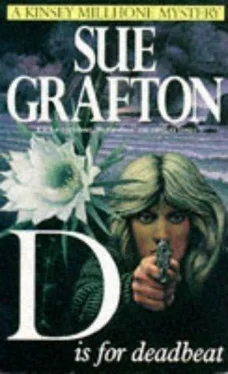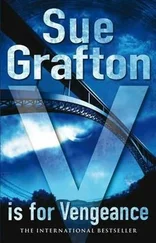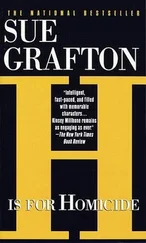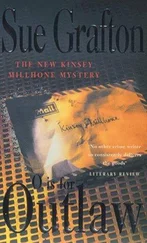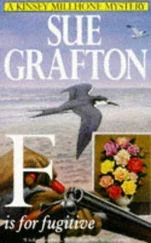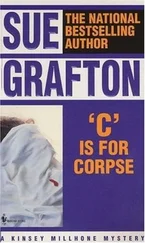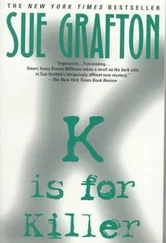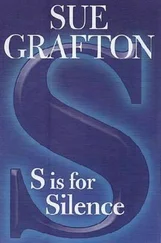I told her the time and place of the services and walked her to the door. After she left, I sat down at my desk again, reviewing everything she'd said. At some point, I wanted to take Tony Gahan aside and see if he could verify her presence at the house the night Daggett died. It was hard to picture her as a killer, but I'd been fooled before.
John Daggett's funeral service took place in the sanctuary of some obscure outpost of the Christian church. The building itself was a one-story yellow stucco, devoid of ornament, located just off the freeway-the sort of chapel you glimpse through the bushes when you're going someplace else. I arrived late. I'd retrieved my VW from the auto glass shop at 1:45 after countless delays, and I confess I'd spent a few contented moments cranking my new car window up and down. The drizzle was beginning to turn serious and I was heartened by the notion that it wouldn't blow straight in on me.
When I reached the gravel parking lot beside the church, there were already fifty cars jammed into space for thirty-five. Some vehicles had nosed out into the vacant lot next door and some hugged the fence along the frontage road. I was forced to pass the place, snag a spot at the end of a long line of cars, and walk back. I could already hear electronic organ music thumping out in a style better suited to a skating rink than a house of God. I noticed from the sign out front that the minister was called a pastor instead of "Reverend" and I wondered if that was significant. Pastor Howard Bowen. The church name was composed of a long string of words and reminded me uneasily of the outfit that distributes pamphlets door-to-door. I hoped they weren't keen on converts.
Mr. Sharonson, from Wynington-Blake, was stand ing by himself on the low front steps and he gave me a pained look as he passed me a mimeographed copy of the program with a hand-drawn lily on the front. His manner suggested that the services were spiritually second-rate, this being the K mart of churches.
I went in. An usher peeled a metal folding chair from a stack near the door and flipped it open for me. The congregation had risen to its feet to sing so I stood in the back row, wedged in among other late arrivals. The woman on my left offered to share her hymnal and I took my half, my gaze sliding over the page in haste. They were on verse four of a ditty that went on and on about blood and sin. I made some mouth noises which I hoped were being lost in the general din. Aside from the fact I don't believe in this stuff, I don't sing too good and I was worried I might be denounced on both counts.
Way up at the front, I thought I spotted Barbara Daggett's blonde head, but I didn't see anyone else I knew. We sat down with a rustle of clothing and the scrape of metal chair legs. While Pastor Bowen, in a matte black suit, talked about what wretches we were, I stared at the brown vinyl tile floor and studied the staunch row of stained glass windows which depicted forms of spiritual torment that made me squirm. Already, I could feel a burgeoning urge to repent.
I could see Daggett's casket up by the altar, looking somehow like one of those boxes magicians use when they cut folk in half. I checked my program. We'd whipped through the opening prayer and the invocation, and now that we'd dispensed with the first hymn, we were apparently settling in for an energetic discourse on the temptations of the flesh, which put me in mind of the numerous and varied occasions on which I'd succumbed. That was entertaining.
Pastor Bowen was in his sixties, balding, a small man with a tight round face, who looked like he would suffer from denture breath. He'd chosen as his subject matter a passage from Deuteronomy: "The Lord shall smite thee in the knees, and in the legs, with a sore botch that cannot be healed, from the sole of thy foot unto the top of thy head," and I heard more on that subject than I thought possible without falling asleep. I was curious what he could find to say about John Daggett, whose transgressions were many and whose repentances were few, but he managed to tie Daggett's passing into "He shall lend to thee, and thou shall not lend to him; he shall be the head, and thou shall be the tail," and sailed right into an all-encompassing prayer.
When we stood for the final hymn, I felt someone's eyes on me and I looked over to spot Marilyn Smith two rows down, in the company of a man I assumed lo be her husband, Wayne. She was wearing red. I wondered if she would leap up and do a lap dance on the coffin lid. The congregation by now was really getting into the spirit of things and hosannas were being called out on all sides, accompanied by amens, huzzahs, and much rending and tearing of clothes. I wanted to excuse myself, but I didn't dare. This was beginning to feel like soul-aerobics.
The woman next to me began to sway, her eyes closed, while she hooted out an occasional "Yes, Lord." I'm not given to this sort of orthodox public outburst and I commenced to edge my way to the door. I could see now that the minister, doing what looked like deltoid releases, was leading his merry band of church elders in the equivalent of a canonical conga line with Essie Daggett bringing up the rear.
At the exit, I came face lo face with Billy Polo and his sister, Coral. He took me by the arm and pulled me aside as the service drew to a close behind me and people began to crowd through the door. Essie Daggett was wailing, nearly borne aloft like a football coach after a big win. Barbara Daggett and Eugene Nickerson had arranged themselves on either side, giving her what protection they could. For some reason, the other mourners were reaching out to touch and pal and grasp at Essie, as if her grief lent her healing powers.
The pallbearers came last, pulling the coffin along on a rolling cart instead of toting it. None of the six of them appeared to be under sixty-five and Wynington-Blake may have worried that they'd collapse, or topple their cargo right out into the aisle. As it was, the cart seemed lo have one errant wheel which caused it lo meander, squeaking energetically. The coffin, as though with a will of its own, headed for the chairs first on one side and then the other. I could see the pallbearers struggle to maintain mournful expressions while correcting its course, dragging it up the aisle like a stubborn dog.
I caught sight of Tony Gahan briefly, but he was gone again before I could speak to him. The hearse pulled up in front and the coffin was angled down the low steps and into the rear. Behind it, the limousine pulled up and Essie was helped into the back seat. She was wearing a black suit, with a broad-brimmed black straw hat, swathed in veiling. She looked more like a beekeeper than anything else. Slung by the Holy Spirit, I thought. Barbara Daggett wore a charcoal gray suit and black pumps, her two-toned eyes looking almost electric in the pale oval of her face. The rain was falling steadily and Mr. Sharonson was distributing big black umbrellas as people ducked off the porch and hurried to the parking lot.
Cars were being started simultaneously in a rumble of exhaust fumes, gravel popping as we pulled out onto the frontage road and began the slow procession to the cemetery, maybe two miles away. Again, we parked in a long line, car doors slamming as we crossed the soggy grass. This was apparently a fairly new cemetery, with few trees-a wide flat field planted to an odd crop. The headstones were square cut and low, without any of the worn beauty of stone angels or granite lambs. The grounds were well kept, but consisted primarily of asphalt roadways winding among sections of burial plots that had apparently been sold "pre-need." I wondered if cemeteries, like golf courses, had to be designed by experts for maximum aesthetic effect. This one felt like a cut-rate country club, low membership fees for the upstart dead. The rich and respectable were buried someplace else and John Daggett couldn't possibly qualify for inclusion among them.
Читать дальше
